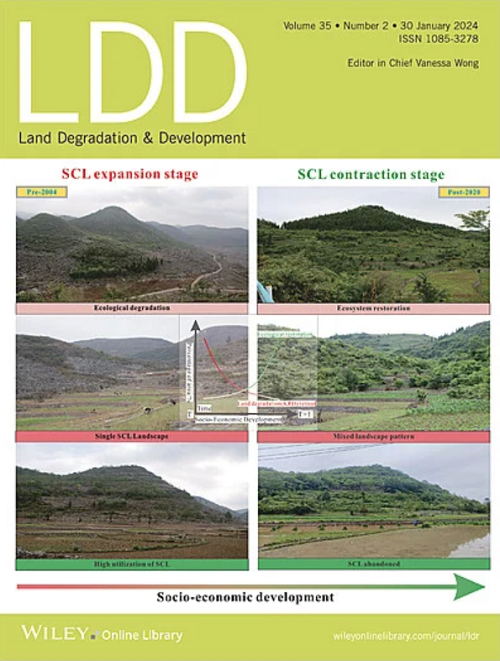Leaf Accumulation Capacity of Herbaceous Plants Growing on Fields Contaminated With Anthropogenically Induced Potentially Toxic Elements Under Natural Soil Conditions
IF 3.6
2区 农林科学
Q2 ENVIRONMENTAL SCIENCES
引用次数: 0
Abstract
Estimation and knowledge of potentially toxic elements (PTEs) in soils and herbaceous plants are vital for ecotoxicological reasons. This study explored PTE accumulation in the aerial organ (leaf) of herbaceous plants in PTE-contaminated soils in a linear transect of three localities close to the Litavka River in Pribram, Czech Republic. Leaf accumulation answers questions on PTE hyperaccumulation and removal during phytoremediation. The study adopted the pseudo-total extraction (aqua regia soluble) of PTE contents (Cd, Cu, Zn, Pb, and Ni) of soil and leaf samples determined by inductively coupled plasma optical emission spectroscopy. Except for Ni, the contents of Cd, Cu, Pb, and Zn were above the permissible limits in soil following WHO with contamination factors ranging from moderate to serious contamination in the sites. Of the 118 herbaceous species in the sites, 43% (52 species) accumulated Cd above the WHO limit in leaves with Geranium pusillum Burm. f. having the highest content (0.84 mg kg−1) while only Geum urbanum L. (132 mg kg−1) and G. pusillum (166 mg kg−1) were above the limit that supports the principal option to clean the infested soils. There was a low bioaccumulation of all plants indicated by a bioaccumulation factor less < 1 (BAFleaf < 1) with PTE content lower than reported hyperaccumulator values. The hyperaccumulation status of PTE of plants stated by previous authors in leaves can be unreliable, under natural soil conditions, accumulations can even be lower than the permissible limits. Further studies requiring different soils and other plants are needed to make a reliable inference on which organs of plants support hyperaccumulation status.在受到人为潜在有毒元素污染的田地上生长的草本植物在自然土壤条件下的叶片积累能力
估计和了解土壤和草本植物中的潜在有毒元素 (PTE) 对于生态毒理学至关重要。本研究探讨了捷克共和国普里布拉姆利塔夫卡河附近三个地区受 PTE 污染土壤中草本植物气生器官(叶片)中 PTE 的积累情况。叶片积累回答了植物修复过程中 PTE 过度积累和清除的问题。研究采用假全萃取法(王水可溶法),通过电感耦合等离子体光发射光谱法测定土壤和叶片样本中的 PTE 含量(镉、铜、锌、铅和镍)。除镍外,镉、铜、铅和锌的含量均高于世界卫生组织规定的土壤允许限值,污染程度从中度污染到严重污染不等。在研究地点的 118 种草本植物中,43%(52 种)的叶片中镉的累积量超过了世界卫生组织的限制,其中 Geranium pusillum Burm. f. 的含量最高(0.84 毫克/千克),而只有 Geum urbanum L. (132 毫克/千克)和 G. pusillum (166 毫克/千克)的含量超过了限制,这支持了清洁受污染土壤的主要选择。所有植物的生物蓄积性都很低,生物蓄积系数小于 1(BAFleaf < 1),PTE 含量低于报告的高蓄积值。前人所述的植物叶片中 PTE 的高积累状态可能并不可靠,在自然土壤条件下,积累量甚至可能低于允许限值。需要对不同土壤和其他植物进行进一步研究,才能可靠地推断出植物的哪些器官支持高积累状态。
本文章由计算机程序翻译,如有差异,请以英文原文为准。
求助全文
约1分钟内获得全文
求助全文
来源期刊

Land Degradation & Development
农林科学-环境科学
CiteScore
7.70
自引率
8.50%
发文量
379
审稿时长
5.5 months
期刊介绍:
Land Degradation & Development is an international journal which seeks to promote rational study of the recognition, monitoring, control and rehabilitation of degradation in terrestrial environments. The journal focuses on:
- what land degradation is;
- what causes land degradation;
- the impacts of land degradation
- the scale of land degradation;
- the history, current status or future trends of land degradation;
- avoidance, mitigation and control of land degradation;
- remedial actions to rehabilitate or restore degraded land;
- sustainable land management.
 求助内容:
求助内容: 应助结果提醒方式:
应助结果提醒方式:


